Soy Sauce Eggs or Ramen Eggs, as they’re sometimes known, are my favourite part of a bowl of ramen; soft, medium, or hard boiled eggs marinated in a delicious mixture of soy sauce, rice vinegar, a hint of brown sugar, green onion, ginger, garlic, and hot peppers.
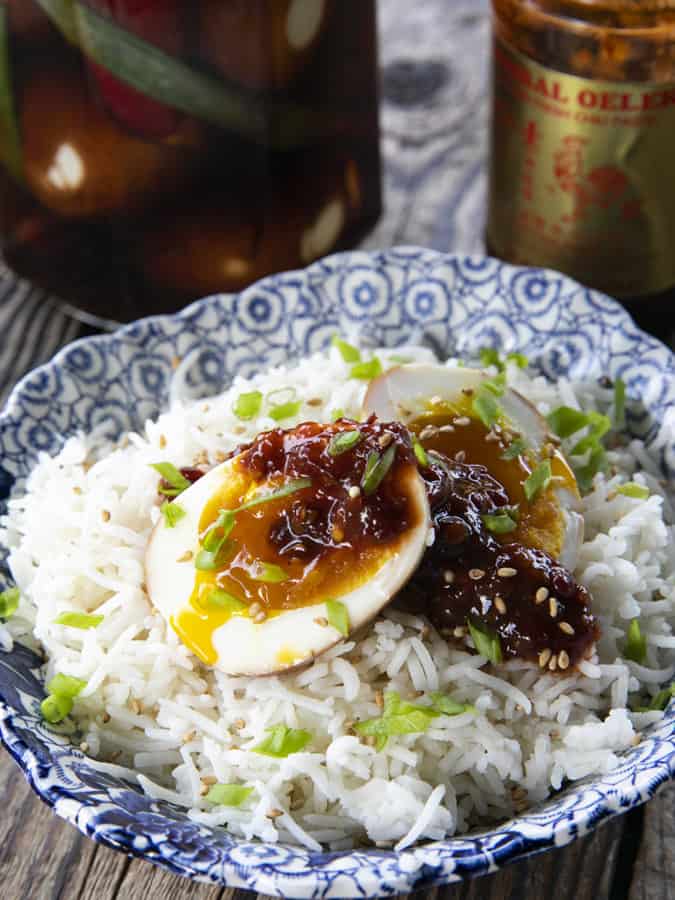
They are as easy as can be to make, and they’re nice to keep on hand in the refrigerator. They’re more than just ramen eggs, too, though! These soy sauce eggs are terrific in all sorts of dishes.
My bonus mom, Val, was an amazing cook. She had the ability to take the most humble ingredients and turn them into food that wasn’t merely great, it was an experience.
Val’s Soy Sauce Eggs are the perfect example of her ability to make comfort food exciting. How can egg possibly be exciting?
Val made them magical by plunking plain old hard boiled eggs into a mixture of soy sauce, vinegar, brown sugar, garlic, ginger, and green onions and left them there until they soaked up all the goodness those delicious things had to offer.
Those regular eggs transformed into umami bombs. Depending on how long they stayed in the brine, they could deliver anything from a delicate whiff of soy and aromatics to a serious punch of flavour. They were always a welcome sight at the table.
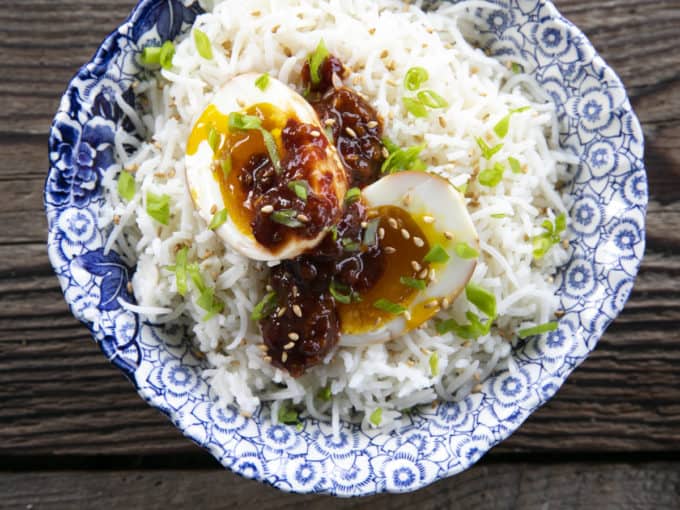
Normally, Val’s Soy Sauce Eggs were served over congee (jook or juk) with a host of other simple odds and ends like sliced green onions, leftover chicken, a bottle of toasted sesame oil, and steamed broccoli. This is a meal that defies modern convention where complicated things rule the day.
Normal ingredients that can be found in small towns take a little international trip to Comfort Land. Hyperbole? Why don’t you try a batch of Val’s Soy Sauce Eggs and tell me?
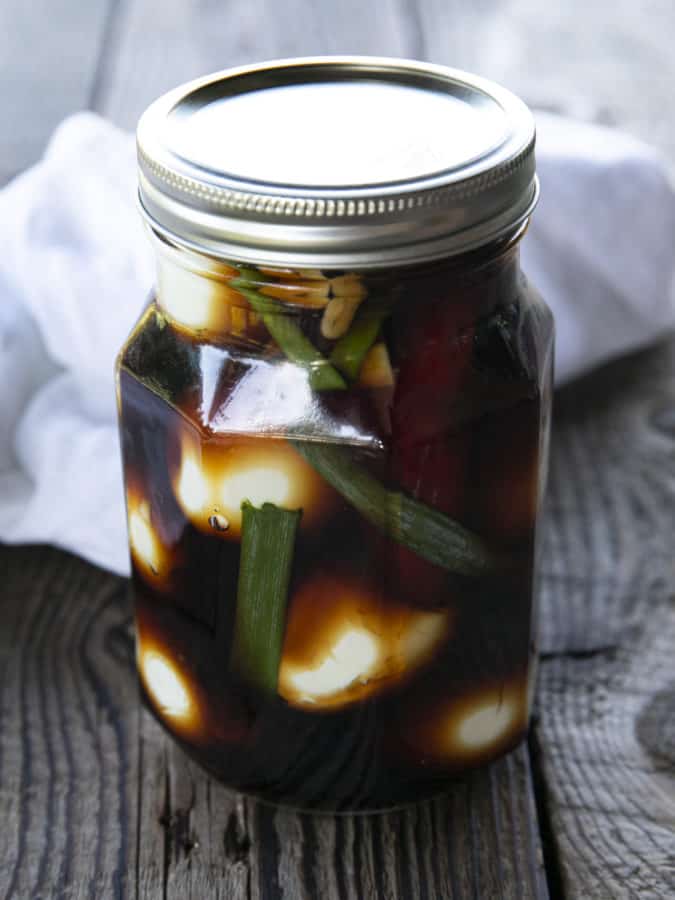
Instant Pot Boiled Eggs
I use the instant pot counter top pressure cooker to make all of my boiled eggs, whether they’re soft boiled, medium boiled jammy eggs, or hard boiled eggs. Here’s a simple list of times presuming you start with refrigerated eggs.
- Soft Boiled Eggs (set whites, runny yolks): 3 minutes on high pressure, quick release, instant ice bath for at least 5 minutes.
- Medium Boiled Eggs (firmer whites, jammy, thicker, but not runny yolk): 4 minutes on high pressure, quick release, instant ice bath for at least 5 minutes.
- Hard Boiled Eggs (firm whites, firm but not chalky yolks): 5 minutes on high pressure, quick release, instant ice bath for at least 5 minutes.
If you have trouble peeling hard-boiled eggs, your issue may be either how fresh they are or how you’re cooking them; super fresh eggs are beastly to peel. The solutions are to use eggs that are at least 2 weeks old OR to use a pressure cooker.
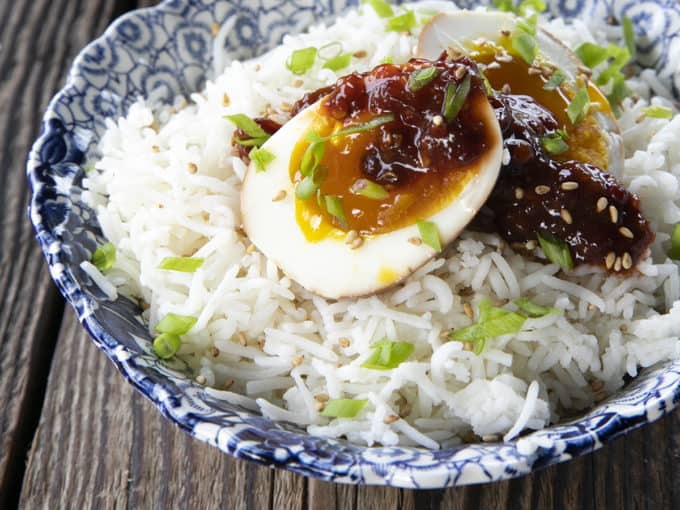
How to Boil Eggs in Instant Pot
Add 1 cup of water to your pressure cooker, place a vegetable steamer basket over the water, and pile high with fresh eggs.
Fix the lid in place, set the vent to seal, and cook using the times above on HIGH pressure. Immediately following the cooking cycle, turn off the machine, and release the pressure instantly.
Then, as soon as the metal rod drops into the lid, lift the lid carefully, directing the steam away from your face. Transfer the eggs carefully to an ice water bath, and let rest there for 5 minutes.
Tap the fat end of the egg, then narrow end, then tap carefully on the counter to break up the shell. The egg whites may be more delicate if you’ve opted for soft-boiling, so handle carefully.
Voila! They should peel like a dream.
Soy Sauce Eggs
You can leave Val’s Soy Sauce Eggs a.k.a to soak for as few as 2 hours (for a gentle soy sauce flavour) or up to two days for a stronger, saltier flavour. I always leave mine to soak for at least a day, because I find eggs have a tendency to swallow other flavours unless I have them there in large quantities.
Even at 24 to 48 hours, I don’t find the soy sauce presence overwhelming. Val started making these years upon years ago after reading a Madhur Jaffrey cookbook.
Over time, she had changed the recipe so much that it was truly hers. I modified Val’s recipe ever so slightly to account for my higher desire for a very strong soy presence in my egg.
I use either low sodium soy sauce or Bragg’s Liquid Aminos for the soy sauce component in my ramen eggs. Either works well.
How do you serve Soy Sauce Eggs? So many ways! We like them alone as snacks, but that’s not even close to all!
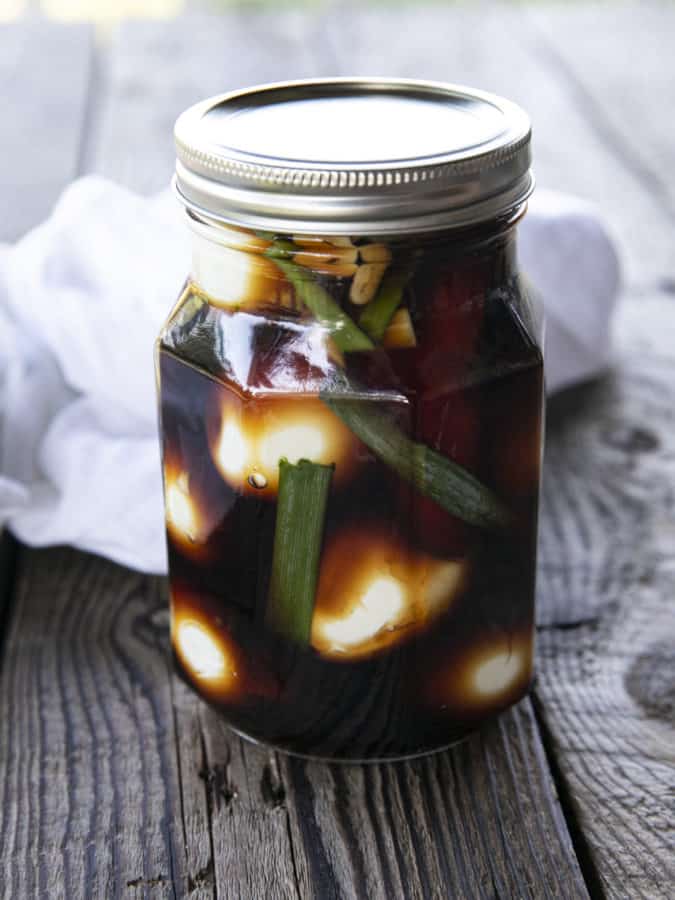
I love them on congee like Val served them. Obviously these ramen eggs are a natural over a beautiful, big bowl of homemade instant pot ramen.
We both love them chopped up and tossed into an Asian chopped salad, or over a BIG GREEN SALAD of any kind. The whole family loves them as shown above, simply sliced in half and served on a bowl of rice with sambal oelek or another hot sauce, a handful of sliced green onions, and a giant serving of Asian Marinated Cucumber Salad.
This is one of our household’s favourite last-minute meals; it’s perfect for busy nights when we don’t want the gut-rot of a fast-food meal, but we have to be quick about procuring and eating food.
Word to the wise: You’d be hard pressed to find a better accompaniment to a cold beer than Soy Sauce Eggs. They’re also tremendous served with Shishito Peppers for a quick light meal.
So how will you serve your soy sauce eggs?
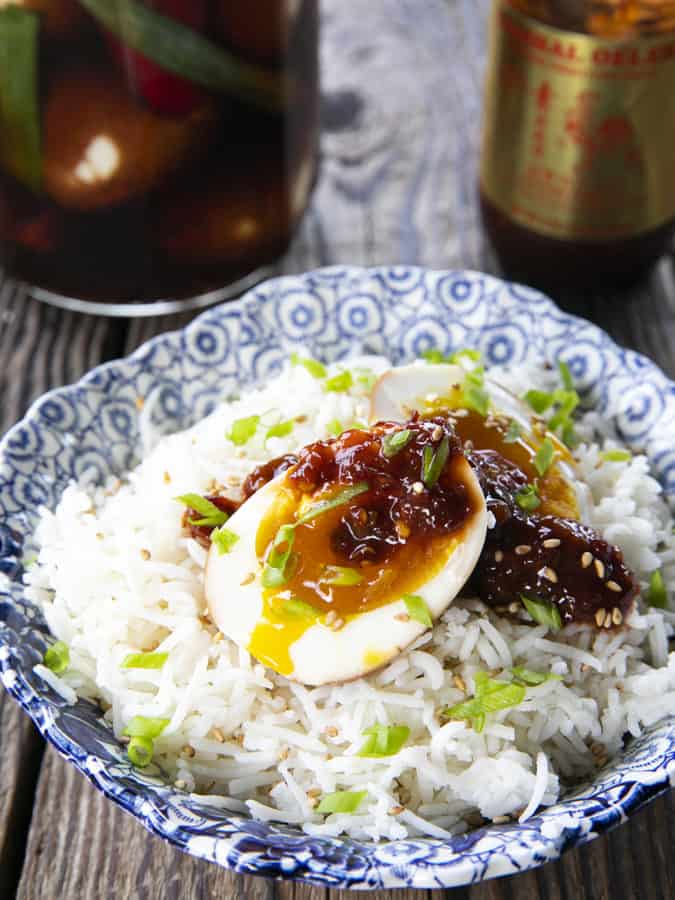
Connect with Foodie with Family
facebook | pinterest | instagram | twitter
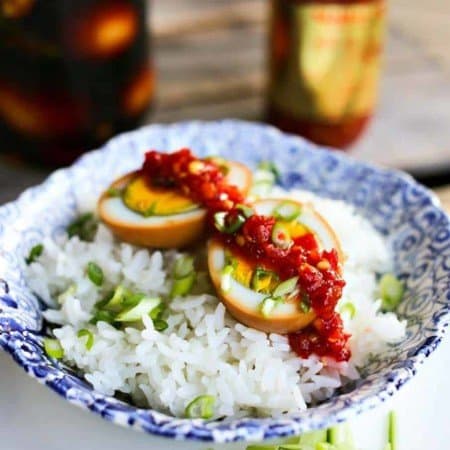
Val’s Soy Sauce Eggs
Rate RecipeIngredients
- 2 packed tablespoons brown sugar
- 4 garlic cloves peeled and minced
- 2 green onions trimmed and cut in half
- 1/2- inch piece of ginger sliced thinly or smashed with a meat tenderizer to loosen up the juices
- 1/2 to 1 whole hot pepper jalapeno, fresno, bird chile, etc… your preference, washed and thinly sliced
- 3/4 cup low sodium soy sauce
- 2 tablespoons rice vinegar
- 6 tablespoons boiling water
- 8 soft boiled eggs or medium or hard boiled eggs, peeled
Instructions
- Add the brown sugar, garlic cloves, green onions, ginger, and hot pepper to a clean quart sized jar. Pour the boiling water over the top and swirl to dissolve the sugar and release the aroma from the aromatics. Pour in the soy sauce and rice vinegar. Swirl gently. Plunk the eggs into the mixture, pressing gently to make sure they’re all submerged. Lid tightly, invert the jar a couple of times, and stash in the refrigerator. They can be used as soon as 2 hours after soaking, but can be left up to 24 hours in the mixture to enhance and deepen the soy sauce flavour.
- Serve cold, room temperature, or heated up, alone with a little sprinkling of togarashi or black pepper, or over rice, congee/juk, ramen, salad, or any other place you think an umami-packed, fragrant, soy sauce flavoured egg would be welcome.
Nutrition
Nutritional information is an estimate and provided to you as a courtesy. You should calculate the nutritional information with the actual ingredients used in your recipe using your preferred nutrition calculator.
did you make this recipe?
Make sure to tag @foodiewithfam on Instagram and #hashtag it #foodiewithfamily so I can check it out!
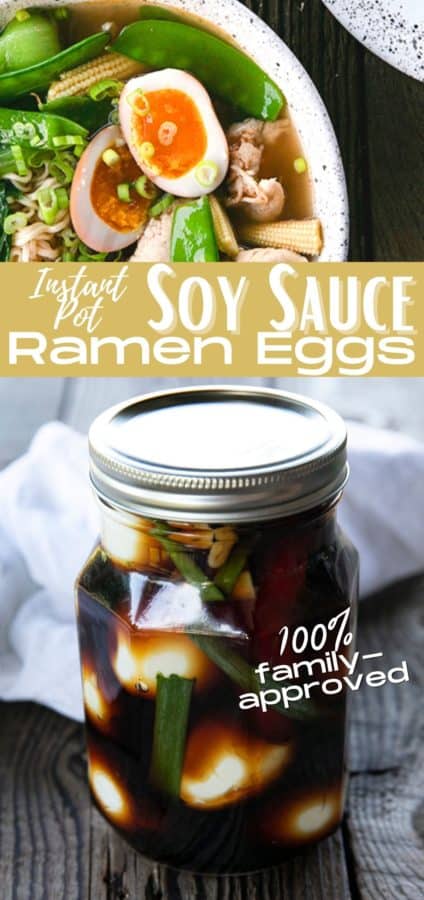
Originally published May 22, 2015. Revised and republished July 2021.
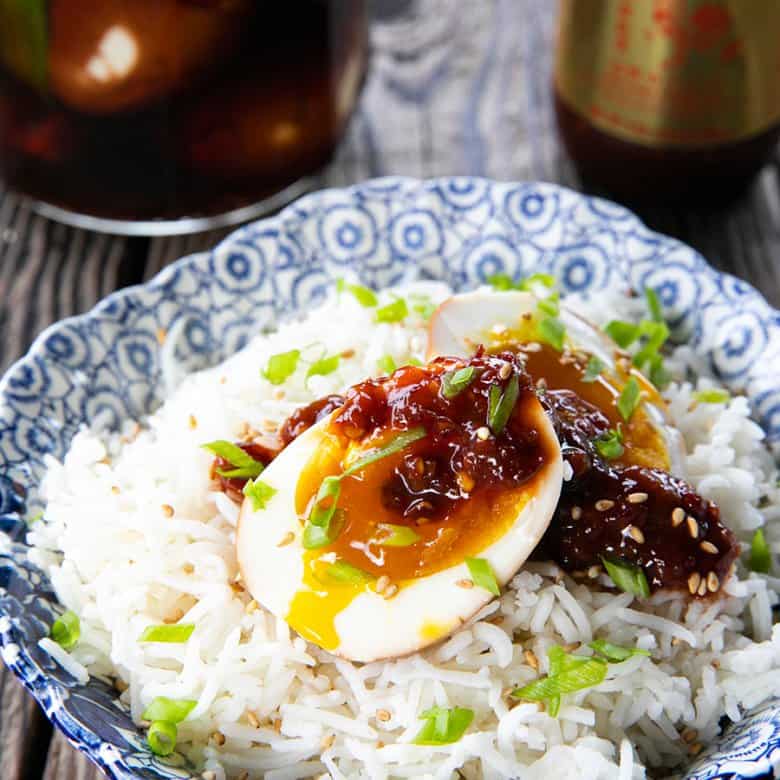
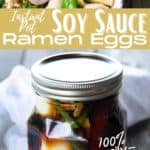



Reader's Thoughts...
Lisa says
Sorry my mistake. I totally missed the insta pot section. 🤦♀️
Rebecca says
No worries 🙂
Lisa says
I may be missing something but I don’t see how long to cook the eggs in the Insta pot
Maureen says
This may be a dumb question but… What would be the best way to heat these up? Is putting them in warm ramen the only way? Thank you for this recipe ! I appreciate you! 🙂
Rebecca says
You’re so kind, Maureen! I usually gently heat them in the broth and that’s a great question!
Trudi says
How long will these last
Rebecca says
Hey Trudi! I’d say they’ll be good for up to a week in the refrigerator. We never have them last that long, though, because we eat them. 🙂